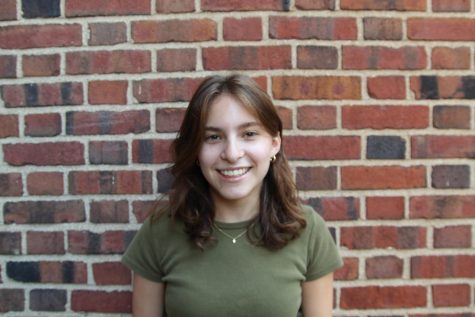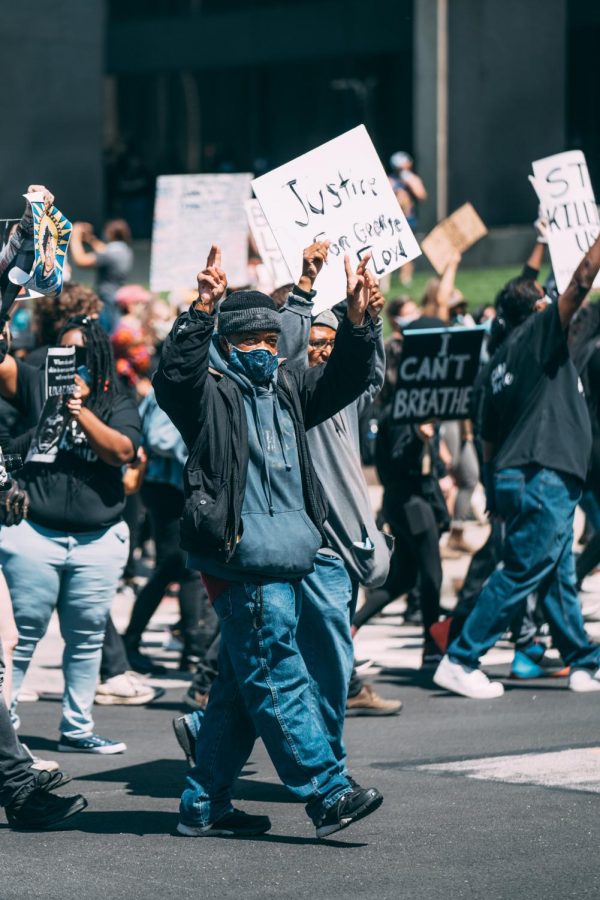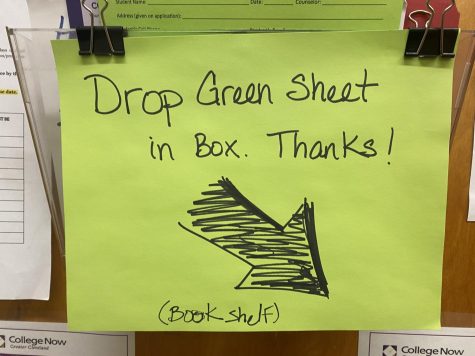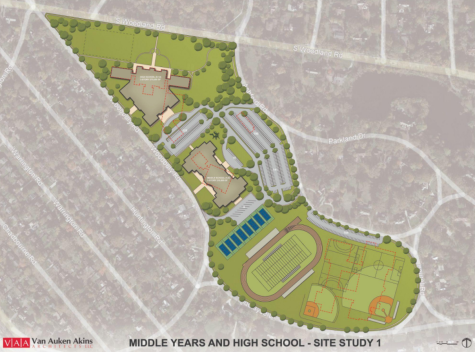America’s Double Standard
The messages and demographics of protesters influence police response
Man holds up peace signs at a May 30 protest in downtown Cleveland.
A group protesting police brutality in downtown Cleveland on May 30., following the murder of George Floyd was met with tear gas and rubber bullets, while the insurrectionists of Jan. 6 were faced with little to no police response.
A group of mostly white Trump supporters stormed the Capitol building Jan. 6, protesting the results of the 2020 presidential election while Congress was counting the electoral votes. The insurrection resulted in the loss of five lives, 140 injuries and almost no police response or intervention.
Approximately 800 insurrectionists entered the building with no repercussions after breaching police barriers, but only 14 were arrested during the Jan. 6 assault. Throughout the incident, the police remained peaceful, even when protestors shattered windows; beat officers with their own shields, pieces of scaffolding and a fire extinguisher; and sprayed bear mace in their faces.
During the summer, 15-26 million Americans took to the streets to protest police brutality and systemic racism. These Black Lives Matter protesters too often faced tear gas and excessive force at the hands of police.
The insurrectionists of the Capitol riot were protesting the results of the 2020 presidential vote as Trump supporters, following his lead, claimed the election was stolen and that there was evidence of voter fraud. Despite the certification of Biden’s presidential win and the lack of evidence to support the claims of fraud, Trump supporters continue to support these false claims. Through tweets, Trump encouraged these conspiracy theories and baseless claims.
Insurrectionists were seen in pictures carrying confederate flags through the Capitol halls and damaging the building. One rioter was pictured wearing a sweatshirt that read “Camp Auschwitz.” The insurrectionists’ messages and actions were not enough for police to use force to control and expel the rioters, unlike their use of tear gas, clubs, and force against peaceful Black Lives Matter protesters.
Some of the insurrectionists were off-duty police officers, former police officers as well as former and current members of the military.
In one video, a rioter is hitting an officer with what looks like a crutch. Others are throwing flags, one of which reads “Trump 2020,” at police as the crowd cheers them on. Another looks to be attempting to detach an American flag from a flag pole to use as a weapon. They attacked Capitol police, one of whom died, yet none were beaten, shot or killed.
Junior, Journee Byrd-Allen wrote,“On several occasions, Black Lives Matter protests have turned violent and Black people were beaten in the street, and even ran into by police in their cars. On the other hand, white people were able to raid a government building, bring hate flags inside, steal federal mail, and more. There was little to no violence during the insurrection itself which already proves the double standard argument.”
Eventually, a 6 p.m. curfew was ordered by the Washington, D.C. mayor, and the rioters were asked to leave the premises. They were warned that if they did not leave, they would be arrested, yet insurrectionists refused to leave and faced no consequences.
Government officials, such as House Speaker Nancy Pelosi, criticized the reaction of the Capitol police. Pelosi directed a review of the Capitol Police, which was released on March 5. The report stated that the Capitol Police were “understaffed, insufficiently equipped, and inadequately trained to secure the Capitol and Members when violently attacked by a large mob.”
According to the Armed Conflict Location and Data database, 93 percent of those who protested police brutality last summer have not engaged in violent activity during a protest. Yet the reactions of law enforcement to Black Lives Matter protests have been severe compared to groups of mostly white protesters. Peaceful protesters were arrested and assaulted for marching in the streets to demand an end to police brutality and demanding justice.
Unlike the insurrectionists of Jan. 6, protesters were arrested despite not committing any crimes. The wide majority of Black Lives Matter protesters did not trespass, beat police officers or destroy or steal government property. However, they were still arrested at a higher rate than white pro-Trump protestors.
In Aurora Colorado on June 29, riot police stormed a peaceful vigil for Elijah McClain. McClain was a 23-year-old Black massage therapist and violinist. Aurora Police officers Nathan Woodyard, Jason Rosenblatt and Randy Roedema killed McClain in 20019 after placing him in a chokehold and sedating him with an improper dose of ketamine. The vigil, which was peaceful, was interrupted when officers arrived and sprayed protesters with tear gas.
Trump called Black Lives Matter protesters in Minneapolis “thugs,” despite the majority being peaceful. After pleas and demands that he ask the insurrectionists to go home, he tweeted, “go home in peace” and that the insurrectionists are “very special.”
The Capitol riot was not the first instance of law enforcement double standards for handling protests. When lockdown orders were enacted by local officials to stop the spread of COVID-19 across the country, protests erupted. Armed militias protested inside and outside the Michigan State Capitol April 30. Most were white and were not wearing masks, which posed another safety threat. Despite the threats to security, law enforcement did not intervene. Instead, police officers merely stood in front of the protesters as they screamed in their faces and brandished assault weapons. They did not use any force, let alone excessive force, as they did during Black Lives Matter protests.
Congresswoman Rashida Tlaib (D-MI) pointed out the double standard. “Black people get executed by police for just existing, while white people dressed like militia members carrying assault weapons are allowed to threaten State Legislators and staff,” Tlaib tweeted April 30.
Meanwhile, on May 30, 2020, thousands of protesters gathered in downtown Cleveland to protest the murder of George Floyd and systemic racism. The protest began peacefully at the Free Stamp. When Cleveland police and Cuyahoga County sheriff’s deputies arrived downtown, the protest escalated. Some protesters threw items at the Justice Center building. Police threw tear gas canisters into the crowds of protesters and used pepper spray against them.
The protesters were throwing objects such as water bottles at the Justice Center building, compared to the insurrectionists of Jan. 6, who threw objects such as flag poles and crutches at police officers.
Senior Victoria Helmick spoke to The Shakerite following the protest. “It was chaotic,” she said. “We saw a girl who got shot by a rubber bullet in her head and she was in shock.”
According to a Pew Research Survey from June 12, Black Lives Matter protests are uniquely diverse. According to a June survey, 17 percent of Black Americans, 22 percent of Hispanic Americans, 8 percent of Asian Americans and 46 percent of white Americans reported attending a Black Lives Matter protest in the month of May.
The majority of the protestors at the Capitol insurrection and the lockdown protest in Michigan were white. The same people who expressed fervent support for police during the height of Black Lives Matter protests abandoned that support during the Capitol riot.
The double standards are alarmingly clear. Law enforcement responds differently based on the skin colors of the protesters, as well as their messages.
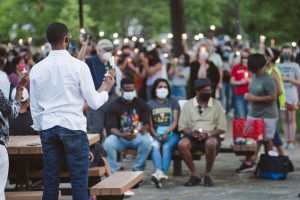
“As a Black person, it makes me feel as though I can not trust the police. I am terrified to ever call if I feel threatened because when and if they arrive they may think I am the threat simply because I am Black. It seems Black peoples rights are limited and white peoples rights are not”, said Byrd-Allen.
Last summer, there were violent protests, which were exceptions to the widely peaceful protests by Black Lives Matter protesters. In Minneapolis property was destroyed, burned, and objects were stolen. Because of these instances, the city of Minneapolis prepared for protests as the Derek Chauvin trial came to an end. Barriers were put up surrounding the courthouse and around businesses where the trial took place.
Chauvin was found guilty of second-degree unintentional murder, third- degree murder and second-degree manslaughter for having knelt on the neck of George Floyd. Protesters gathered outside of the boarded-up courthouse, listening through cell phones to hear the verdict for each charge. The crowd erupted in cheering, crying and praying when Chauvin was found guilty on all of them. Despite their intense emotional reactions, those gathered outside the courthouse remained peaceful.
Shaker schools held an assembly Jan. 12 to address the insurrection. Eight Black students voiced their opinions on the event and pointed out the hypocrisy in law enforcement reactions to insurrectionists compared to that of Black Lives Matter protesters.
“To go to the Capitol and riot, for the reasons that they did, is revolting. Given that one [protest] is losing an election and the other one is standing up for your life, it’s pretty absurd,” seventh grader Bahji Jenkins said.
Junior Ayande Joseph also spoke at the district event. He said, “On one side, you have the terrorists taking selfies with the police officer inside the building, and then on the other hand, you have peaceful protesters being shown plenty of violence for peacefully protesting. It’s just Black and white of the double standards.”
A version of this article appears in print on pages 26-29 of Volume 91, Issue I, published May 28, 2021.
Comment using your Facebook, Yahoo, AOL or Hotmail account
